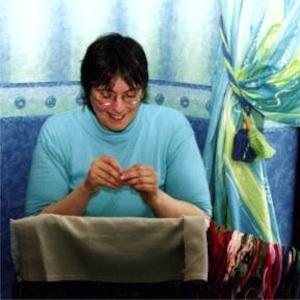- Home
- How to Thread a Needle
How to thread a needle using a needle threader
Have you ever struggled with how to thread a needle?
You're not the only one!
Threading a needle can be really frustrating and make even the most patient people feel defeated.
Imagine the following situation
You have a beautiful embroidery project in front of you, the vibrant colors of thread waiting to be stitched into a masterpiece. But first, you need to tackle the simple task of how to thread a needle.
That shouldn't be too difficult, eh?
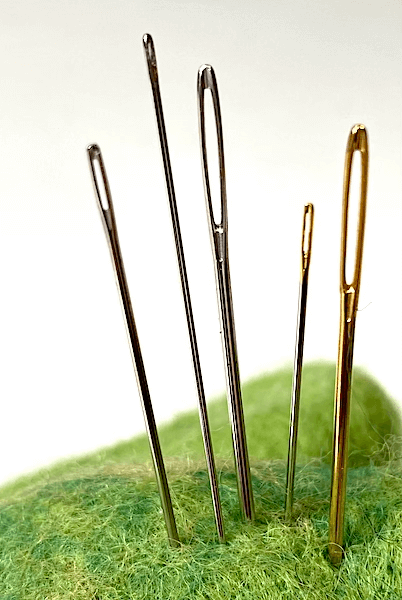 Crewel, embroidery, chenille, tapestry and milliner's needles
Crewel, embroidery, chenille, tapestry and milliner's needlesHolding the needle between your fingers, your grip determined. Carefully, you trim the end of the thread at a slight angle, fashioning a pointed tip. Poised, you aim to guide it through the eye of the needle. But then, it's like the thread has a mind of its own, evading capture and slipping through your fingers like a slippery fish.
You pause for a moment, trying to remain calm. Surely the task ahead should be straightforward and manageable?
But as you try again and again, the needle and thread become an elusive puzzle that you just can't seem to solve.
It's at this moment that frustration sets in. You question your abilities, your sanity, even.
How can something so tiny cause so much distress?
The simple act of threading a needle suddenly feels like an insurmountable challenge.
Threading a needle can be a real pain, especially if you have vision or hand dexterity issues.
Luckily, there's a handy tool that can make this task a breeze – the needle threader. This small device can make all the difference in simplifying the threading process.
Before we look at needle threaders, there are some things we need to consider first about how to thread a needle.
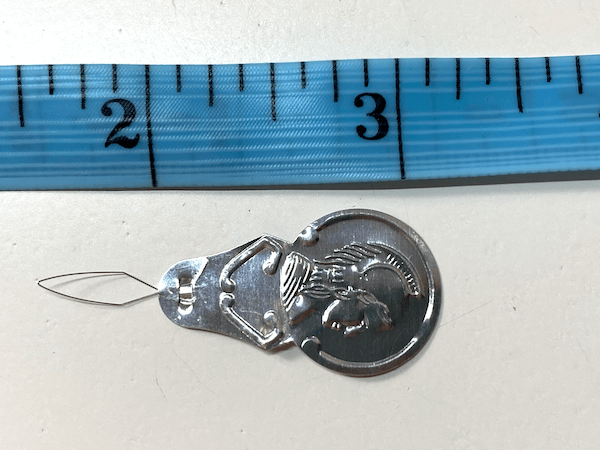
Choosing the right needle size
With embroidery needles, one size does not fit all.
Different fabrics require different needle sizes to ensure the best results. So, how do you make sure you are using the most appropriate needle? Let's look closer.
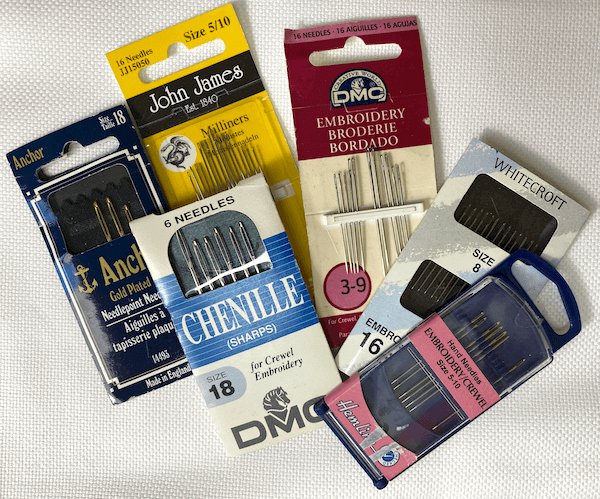 Some of my embroidery needle collection!
Some of my embroidery needle collection!Consider the fabric
The first step is to consider the fabric you'll be stitching on. Fabrics vary in thickness and density, and the needle you choose should match these characteristics.
- For lightweight fabrics like silk or organza, opt for a finer needle size, such as 9 or 10.
- For medium-weight fabrics like cotton or linen, a size 11 or 12 needle will work well.
- And for heavier fabrics like denim or canvas, go for a larger needle size, such as 14 or 16.
Consider the thread
The thread you'll be using also influences the needle size.
Thicker threads, such as pearl cotton or tapestry wool, require a larger needle size to accommodate their bulk.
Finer threads like silk thread or embroidery floss thread work best with smaller needle sizes.
But what if you want to use multiple strands of thread?
In this instance, you need to consider the joint thickness of the combined strands when choosing your needle.
Test and Adjust
Testing your needle and fabric choice before transferring your pattern is a wise move.
This way you will feel how easily the needle slips through the fabric, and whether it leaves a hole that the thread will not fill. You will also discover whether you need to exert force on the needle in order for it to penetrate a thicker fabric.
Either way, a quick test will instantly suggest whether adjustments are necessary.
The end of the thread
While it may seem like a minor detail, the condition of your thread can have a significant impact on your threading process.
Trying to push thread with a frayed, unruly end through the eye of a needle is frustrating, time-consuming and can lead to unnecessary stress.
What can you do to make it easier?
- Trim the end - Before starting a new thread, take a moment to trim the end with sharp scissors. This will remove any frayed or uneven parts, leaving you with a clean and manageable end.
- Use a Thread Conditioner - If you're working with a delicate or prone-to-fraying thread, consider using a thread conditioner. These products, such as beeswax or thread gloss, help to strengthen the thread and prevent fraying. Run the thread through the conditioner a few times, and you'll have a smoother, more resilient end.
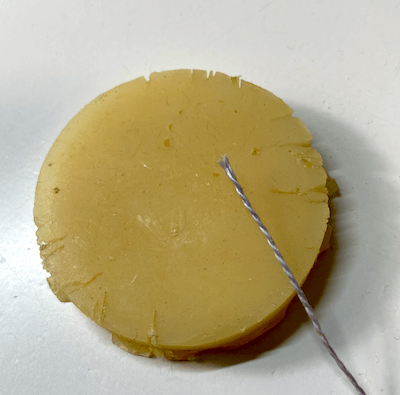 Pearl cotton in front of my beeswax circle
Pearl cotton in front of my beeswax circleIntroducing the needle threader
A basic needle threader is a nifty little tool that comprises a thin wire loop attached to a handle.
It's incredibly easy to use.
Just insert the wire loop through the eye of the needle, then place the end of the thread through the loop. With a gentle pull, voila! The thread effortlessly passes through the eye, saving you time and energy.
How to thread a needle using a wire needle threader
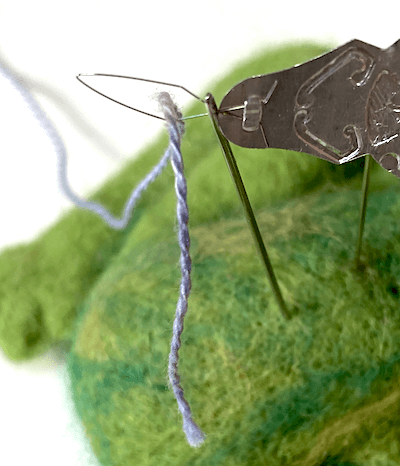 Push the threader through the eye and drop the thread through the wire
Push the threader through the eye and drop the thread through the wire- Hold the needle threader by its handle, making sure the wire loop is facing upward.
- Insert the wire loop through the eye of the needle, ensuring that it goes all the way through.
- Take the end of your thread and pass it through the wire loop. Leave a tail of thread hanging out.
- Carefully pull the needle threader back through the eye of the needle, bringing the thread with it. Voila! Your needle is now threaded and ready to go.
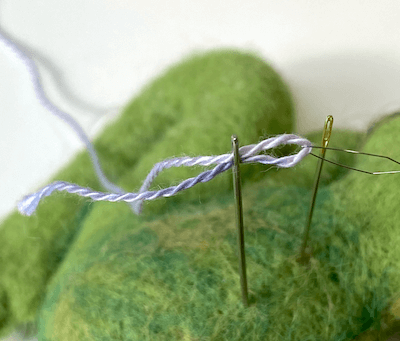 Pulling the threader and thread through the needle eye
Pulling the threader and thread through the needle eyeUsing a basic wire loop needle threader takes the frustration out of learning how to thread a needle. It's a simple yet effective tool that can save you time and spare you from squinting and straining your eyes.
But wait, there's more! In the next section, we'll explore other types of needle threader that take threading to a whole new level of convenience and efficiency.
Get ready for the automatic needle threader—the ultimate threading hack.
Other types of needle threader
Now that we understand what a needle threader is and why it's beneficial, let's dive into the different types available in the market.
There are several options to choose from, each with its own unique features and functionality.
Besides its threading capabilities, some needle threaders come with additional features, such as built-in thread cutters or storage compartments for needles. These added functionalities make the needle threader a versatile and practical tool that every embroiderer should have in their toolkit.
Each type of needle threader has its advantages and may appeal to different individuals based on their specific needs and preferences.
Ultimately, the choice depends on what works best for you and your stitching projects.
Automatic Needle Threader
If you want to take your threading game to the next level, an automatic needle threader is worth considering.
This type of threader has a built-in mechanism that automatically pushes the thread through the needle's eye with just a press of a button. It's perfect for those who struggle with manual dexterity or have limited vision.
Needle Threader with LED Light
This is a fantastic option for anyone who needs a little extra help to see the needle's eye. These threaders come with a built-in LED light that illuminates the needle, making it easier to thread even in dim lighting conditions. Say goodbye to squinting and straining your eyes!
Threader with thread cutter
This type of threader combines the functionality of a needle threader with a thread cutter. It has a built-in blade that allows you to trim your thread before it's threaded through the needle. It's a convenient two-in-one tool that saves you time and eliminates the need for a separate pair of scissors.
Self-Threading Needles
While not technically a threader, self-threading needles deserve a mention.
These needles have a small opening at the top that allows you to slip the thread into it, eliminating the need for threading through the eye. They are a great alternative for those who find traditional threading methods challenging.
Time to get your own needle threader?
So, next time you struggle with how to thread a needle, reach for a needle threader and enjoy a stress-free stitching session.
Oh, and in case you were wondering, my needle-felted frog helped me out for the photos of using the needle threader by holding the needle still. Without this help, I would have required three hands!
For more on needle felting click this link.
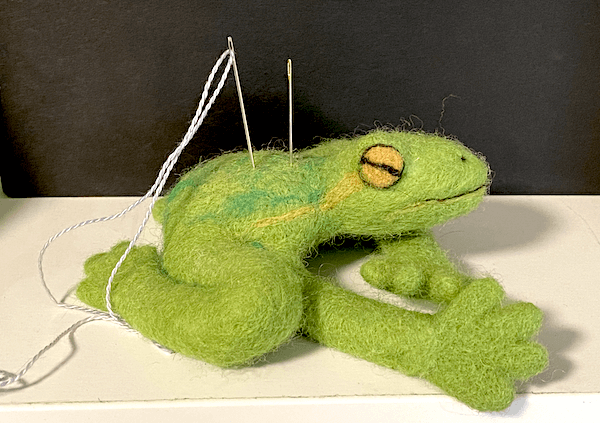 My needle felted frog helper
My needle felted frog helper
Stay connected between projects
If you’d like occasional updates from my embroidery room, including new patterns, gentle tips, and little things I think you might enjoy, you’re warmly invited to join the Stitchin’ Times newsletter.
No pressure. Just a friendly note now and then to keep you inspired.
